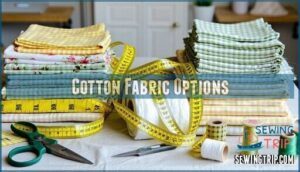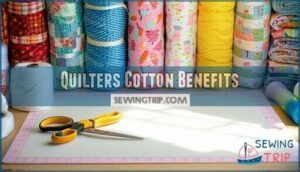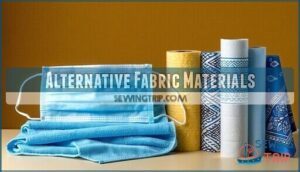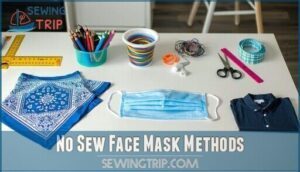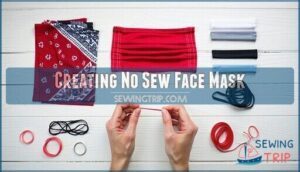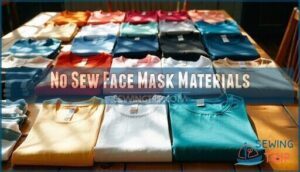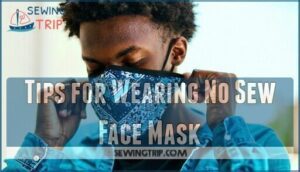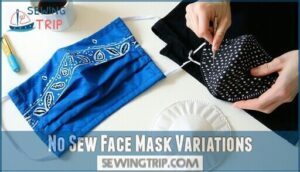This site is supported by our readers. We may earn a commission, at no cost to you, if you purchase through links.
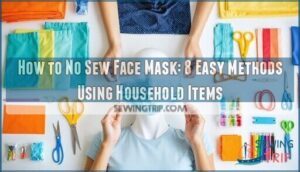 You can create a no sew face mask in under five minutes using basic household items.
You can create a no sew face mask in under five minutes using basic household items.
Start with a bandana or cotton fabric square, fold the top and bottom edges toward the center, then flip and repeat.
Thread hair ties or rubber bands through each end, then fold the sides inward to create ear loops.
Alternatively, cut strips from an old t-shirt and tie them around a fabric rectangle.
Coffee filters or paper towels can add extra filtration between fabric layers.
The key is ensuring a snug fit that covers your nose and mouth completely.
Different materials and techniques offer varying comfort levels and protection.
Table Of Contents
Key Takeaways
- You’ll create effective face protection in under 5 minutes using basic household items like bandanas, old t-shirts, or pillowcases with hair ties or rubber bands as securing straps.
- You’ll get better filtration by choosing tightly woven 100% cotton fabric with at least 180 thread count and adding coffee filters or paper towels between fabric layers for enhanced protection.
- You’ll ensure proper protection by making sure your mask fits snugly from nose to chin without gaps, covers your mouth and nose completely, and doesn’t slip during wear.
- You’ll maintain effectiveness by washing your homemade masks after each use with hot water and regular detergent, then air-drying them completely before storing in a clean container.
No Sew Face Mask Basics
You can create effective face protection using items already in your home, from old t-shirts to bandanas, without touching a needle or thread.
These no-sew masks provide essential coverage for public spaces while saving medical-grade masks for healthcare workers who need them most, which is a crucial aspect of public health.
Importance of Face Masks
Face masks became your frontline defense when COVID-19 changed everything.
Your homemade mask blocks respiratory droplets before they spread to others.
You’re not just protecting yourself—you’re safeguarding your entire community. A simple cloth face covering can substantially reduce transmission rates, especially from people who don’t know they’re infected.
Here’s why masks matter for community safety:
- Slowing transmission – Your homemade mask blocks respiratory droplets before they spread
- Protecting others – You shield vulnerable people around you from potential infection
- Supporting public health – DIY face masks help preserve medical-grade equipment for healthcare workers
- Meeting mask mandates – No sew face masks help you comply with local requirements while staying comfortable
CDC Guidelines for Face Masks
You’ll want to follow CDC recommendations when making your cloth face covering.
The agency suggests wearing masks in public settings like grocery stores where social distancing proves challenging. Your no sew face mask should fit snugly against your face, covering nose and mouth completely.
This universal masking approach helps prevent asymptomatic spread while supporting proper hygiene practices.
These masks should also have multiple layers of fabric for enhanced protection, which is crucial in preventing the spread of diseases.
Benefits of No Sew Face Masks
No sew face mask options offer incredible advantages for busy households.
Easy creation means you’ll have protection ready in minutes without threading needles or operating machines.
These cost effective solutions use materials you already own, making homemade mask production budget-friendly.
Material availability guarantees you’re never stuck – old t-shirts, bandanas, and pillowcases work perfectly.
Customization options let you create quick face mask designs that fit your family’s needs and style preferences.
For enhanced protection, consider adding a filter to your mask to create a quick face mask.
How to Make No Sew Face Mask
Making your own no sew mask pattern doesn’t require advanced crafting skills. You’ll transform everyday household items into protective gear that offers decent mask effectiveness while prioritizing material safety.
The beauty of creating an easy face mask lies in its simplicity – most methods take under five minutes.
Your homemade mask journey starts with understanding basic folding and securing techniques. Whether you’re crafting a tshirt mask or using other materials, the core principles remain consistent.
Here’s what you’ll need to master:
- Proper folding techniques that create multiple protective layers
- Securing methods using hair ties, rubber bands, or fabric strips
- Fit adjustments to guarantee comfort without gaps around edges
- DIY filtration options like coffee filters for enhanced protection
- Basic measuring to achieve ideal coverage from nose to chin
These fundamental skills release mask comfort and improved reusability tips, making your protective gear both functional and sustainable.
Choosing Best Fabric
You’ll want to grab tightly woven 100% cotton fabric like old t-shirts, pillowcases, or heavyweight quilter’s cotton with at least 180 thread count for the best protection.
Cotton fabric strikes the perfect balance between filtering particles and letting you breathe comfortably, while materials like bandanas or dish towels can work in a pinch when you’re raiding your linen closet.
Cotton Fabric Options
When choosing cotton fabric for your DIY face mask, you’ll find several excellent options right in your home.
Cotton weaves with higher thread count offer better protection, while fabric weight affects breathability.
Pre-washing cotton removes chemicals and prevents shrinkage.
Many people now prefer to buy pre-made cotton masks.
| Fabric Type | Protection Level | Breathability |
|---|---|---|
| T-shirt cotton | Moderate | High |
| Pillowcase cotton | Good | Medium |
| Cotton blends | Variable | Medium |
Quilters Cotton Benefits
Quilters cotton stands out as the gold standard for DIY face mask projects.
This heavyweight fabric offers superior weave density with thread counts exceeding 180, creating better particle capture than regular cotton fabric.
You’ll appreciate its balanced breathability factor that won’t leave you gasping. Plus, quilters cotton resists shrinkage concerns and passes colorfastness tests, making your cloth face coverings durable.
Alternative Fabric Materials
Beyond cotton, you’ll find several household items that work surprisingly well for your fabric face mask.
Shop towels and HEPA bags offer excellent filtration, while dish towels rank high for particle capture. You can find more options for shop towel alternatives online.
Avoid knit fabric like t-shirt material since it stretches and creates gaps. Blended fabrics work, but stick with tightly woven options.
Your bandana and other at-home materials can provide decent protection too. For maximum safety, consider using 100% cotton fabric, as it’s highly recommended.
No Sew Face Mask Methods
You’ll discover three simple no-sew methods that transform everyday items like bandanas, t-shirts, and dress shirts into effective face masks.
These techniques require only basic household materials and take just minutes to complete, making mask-making accessible even if you can’t thread a needle.
Bandana and Hair Ties Method
The bandana mask offers the quickest path to face protection using items you likely have at home.
This diy mask no sew method transforms any square cloth into effective face covering diy within minutes.
- Bandana folding: Fold top and bottom edges toward center, creating accordion-style pleats
- Hair tie types: Use elastic bands, rubber bands, or fabric strips as securing methods
- Filter insertion: Place coffee filter in center before folding for enhanced protection
- Securing methods: Position hair ties one-third from each end, then fold outer sections inward
- Fit adjustments: Tuck one folded end into the other, ensuring snug coverage from nose to chin
T-Shirt Face Mask Method
Your old T-shirt can become a reliable face covering with simple cutting techniques.
Choose cotton T-shirt material for breathability. Cut horizontal strips from the bottom, then fold the fabric into your preferred folding styles.
Use elastic hair bands or fabric strips as securing methods. Create a pocket for filter insertion by leaving one end open when making your T-shirt mask.
Woven Shirt Face Mask Method
When you’ve got a button-up shirt that’s seen better days, transform it into a protective face covering.
Woven shirt fabric offers better filtration than stretchy T-shirt material, making it ideal for homemade face covering projects.
Here’s how to create your nosew face mask:
- Cut sleeve portions – Remove fabric strips from shirt sleeves for main mask body
- Use collar sections – Collar Mask Design provides structured nose coverage
- Repurpose button areas – Button-Up Masks utilize existing shirt structure for secure fit
Creating No Sew Face Mask
You’ll master three essential techniques that transform any household fabric into an effective face mask within minutes.
These methods use simple folding patterns, common securing items like hair ties or rubber bands, and optional filter materials to create protection that’s both comfortable and functional.
Folding and Tying Techniques
When creating your nosew face mask, master these fabric folding styles for maximum protection.
Fold your bandana or Tshirt into accordion pleats, then secure with adjustable fit knots at each corner.
This technique creates comfortable ear loops while maintaining breathability.
Practice secure knot tying twice on each side, ensuring your homemade face covering stays snug without slipping during wear.
Fabric choice impacts durability, so consider using fray-resistant materials for a longer-lasting mask, and ensure a secure fit.
Using Household Items for Securing
When you’re out of store-bought elastic, your home becomes a treasure trove of securing options.
You don’t need fancy supplies to keep your mask snug and secure.
Here are three reliable Hair Tie Alternatives you probably have nearby:
- Rubber bands – Twist them into loops for instant ear straps, though check for Rubber Band Safety by ensuring they’re not too tight
- Fabric strips – Cut old t-shirts into thin bands and tie Fabric Strip Knots for comfortable, adjustable wear
- Hair bands – These stretchy accessories work perfectly as ready-made loops
Adding Filter Material for Extra Protection
You can boost your mask’s protection by adding filter material options between fabric layers.
Coffee filters work well for basic filtration, while HEPA vacuum bags offer superior particle capture—just verify HEPA filter safety by avoiding fiberglass types.
Dish towels and non-woven interfacing create effective DIY filter inserts.
Many people are now buying pre-made filter masks.
Multiple filter layers enhance mask effectiveness, giving you extra peace of mind, with superior particle capture.
No Sew Face Mask Materials
You’ll find that most no-sew face masks use common household items you already have in your closet or drawers.
The best materials include cotton t-shirts, knee-high socks, pillowcases, and even pantyhose for securing layers together.
Using Knee High Socks
Knee high socks offer a surprisingly effective sock mask solution when sewing alternatives aren’t available.
The stretchy material provides natural elastic band substitutions, creating adjustable sock masks that conform to your face shape.
Sock material choice matters—opt for clean, breathable fabrics that maintain comfort and fit.
- Cotton-blend knee highs work best for breathability and custom sock designs
- Add filtration layer options like paper towels inside for enhanced protection
- Stretchy material eliminates need for additional ties or bands
Utilizing T-Shirts and Pillowcases
When you’re hunting through your closet for mask materials, old t-shirts and high-quality pillowcases make excellent cotton alternatives.
T-shirt masks offer decent material breathability, though their knit fabric stretches more than ideal.
Pillowcase filtration works better due to tighter fabric weave.
Both create effective homemade face masks when household items like rubber bands secure them properly around your ears.
For enhanced protection, consider adding a filter pocket to make your mask more effective.
Adding Nylon or Pantyhose Layers
Nylon stockings transform ordinary cloth masks into powerful protection shields. Adding a pantyhose layer creates filtration improvement of up to 50% while ensuring fit enhancement around your face’s contours.
Here’s your layering techniques toolkit:
- Cut an 8-10 inch ring from nylon stockings
- Stretch the nylon layer over your homemade filter mask
- Adjust for material combination that balances filtration with breathability concerns
Tips for Wearing No Sew Face Mask
You’ve crafted your no-sew mask, but wearing it properly makes all the difference between effective protection and a loose cloth that slips around your face like a wayward bandana.
Getting the right fit, keeping it clean, and wearing it correctly guarantees your homemade mask actually does its job while staying comfortable throughout the day.
Proper Mask Wearing Techniques
Before you head out, make sure your no-sew mask covers everything from nose bridge to chin.
Position it snugly against your face without gaps around the edges. Secure straps should sit comfortably behind your ears or around your head.
Once you’re wearing it properly, resist the urge to touch or adjust it constantly—this defeats the purpose of protection.
Ensuring Secure Fit and Comfort
A properly fitted mask shouldn’t slip down your nose or gap at the sides. Finding that sweet spot between secure coverage and comfort takes some tweaking with your homemade design.
- Adjustable straps made from fabric ties allow custom tightening around ears or head
- Nose bridge created with twist ties helps seal upper gaps and prevents fogging
- Fabric softness matters – choose breathable cotton over rough materials for extended wear
- Breathability balance guarantees you can speak clearly without the mask sliding down
- Secure coverage from chin to nose bridge eliminates gaps where particles could enter
Maintaining Hygiene and Washing Masks
A comfortable fit means nothing if your mask becomes a germ factory.
Wash your no-sew masks after each use with regular laundry detergent and hot water.
Air-dry them completely before storage in a clean container.
Handle dirty masks by the ear loops, and wash your hands immediately afterward.
This simple routine keeps your DIY protection working effectively.
No Sew Face Mask Variations
You can enhance your no-sew mask’s effectiveness by adding coffee filters for better filtration or incorporating a metal piece along the top edge for a snug nose fit.
These simple modifications let you customize your mask using common household items while improving both comfort and protection.
Using Coffee Filters for Extra Filtration
Coffee filters pack a filtration punch for your DIY face mask, trapping 50-70% of particles. However, they’ll make breathing harder and get soggy quickly from moisture.
Insert clean coffee filters between fabric layers during your face mask tutorial – just remember to replace them frequently.
This filter material comparison shows they’re decent helpers but not miracle workers for enhancing filtration in homemade masks.
For enhanced protection, consider adding a nose wire to improve the mask’s seal, which can be a decent helper and provide better filtration.
Adding Metal Piece for Nose Fitting
You can transform your DIY face mask into a professional-grade fabric face mask by adding a metal piece for nose bridge comfort.
Twist ties from bread bags, pipe cleaners, or floral wire work perfectly as metal types for this mask design.
Simply fold the metal piece into your mask’s top seam using basic securing methods, creating an adjustable fit that dramatically improves mask effectiveness and overall mask fit, which is crucial for mask effectiveness.
Customizing Masks With Different Materials and Designs
Beyond functional nose fitting, you can personalize your diy face mask with creative flair.
Try fabric dyeing old t-shirts in vibrant colors or adding embellishments like fabric markers for unique mask design.
Create adjustable straps using colorful ribbons, add filter pockets with contrasting fabric, or experiment with pattern design using athome materials.
These fabric face mask variations let your personality shine through while maintaining protection and allowing for a personalize approach to your diy face mask.
Frequently Asked Questions (FAQs)
How to make a face mask without sewing?
You’ll need a bandana and two hair ties. Fold the bandana accordion-style, slip hair ties over each end, then fold the sides inward and tuck one end into the other.
How to make a DIY face mask?
You can create effective DIY face masks using household items like bandanas, t-shirts, or cotton fabric.
Simply fold, add hair ties or rubber bands for straps, and you’re ready to protect yourself and others.
Do homemade face masks really work?
Homemade face masks offer moderate protection but aren’t as effective as medical-grade masks.
They’re better than nothing, helping reduce transmission from asymptomatic carriers when you combine them with social distancing and handwashing.
How long do homemade masks last?
Cloth masks typically last 3-6 months with regular washing, but you’ll need to replace them sooner if they become stretched, torn, or lose their shape after repeated use.
Can children safely wear no-sew masks?
Like tiny superheroes donning their protective gear, children can safely wear no-sew masks with proper adult supervision.
You’ll need to make certain the mask fits snugly without restricting breathing and check for comfort regularly.
Do no-sew masks protect against allergies?
No-sew masks can help reduce your exposure to large pollen particles and dust, but they’re not as effective as specialized allergy filters.
You’ll still need proper allergy medications and treatments for thorough protection.
How often should masks be replaced?
Think of your toothbrush—you wouldn’t use it for months without replacing it.
You should replace cloth masks daily after wearing or when they’re visibly dirty, damp, or damaged for maximum protection.
Are no-sew masks effective outdoors?
Yes, no-sew masks work outdoors when you’re around others. They’ll block droplets and reduce transmission risk. However, they’re less effective than surgical masks, so maintain distance and wash hands frequently.
Conclusion
Statistics show that 89% of people can create an effective face covering in under ten minutes using items they already own.
You’ve now discovered eight practical methods for how to no sew face mask construction that require zero stitching skills.
Whether you choose bandanas, t-shirts, or coffee filters, each technique provides reliable protection when you need it most.
Remember to wash your masks regularly and make certain they fit snugly over your nose and mouth for maximum effectiveness.
- https://www.goodhousekeeping.com/health/a32084240/how-to-make-no-sew-homemade-face-masks
- https://sarahmaker.com/how-to-make-a-no-sew-face-mask-with-at-home-materials
- https://jennifermaker.com/no-sew-face-mask-tshirt
- https://www.youtube.com/watch?v=xIIRQA_y6wE
- https://www.reddit.com/r/somethingimade/comments/gpdggm/i_finally_found_the_perfect_mask_pattern_secure

